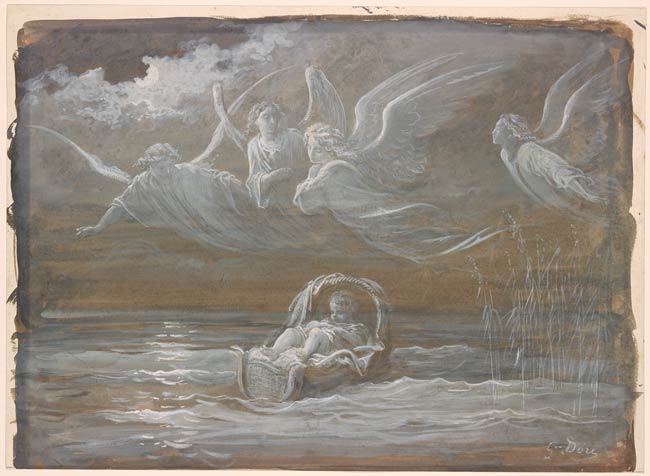
Doré designed 241 vignettes to illustrate the old and new testaments for a luxury edition of the Vulgate Bible using a new 1843 French translation. Known as "La Grande Bible de Tours," and published as "La Sainte Bible selon la Vulgate" (2 vols., Tours, Alfred Mame et Fils, 1866), the book soon became commonly called the Doré Bible. Héliodore Joseph Pisan produced woodcut engravings reproducing in the same direction Doré designs. It was one of the most popular publications of the nineteenth century, and it was soon translated into at least 24 languages in editions that retained Doré vignettes. The book's success inspired Doré to produce monumental paintings after some of the scenes for display in his Doré Gallery in London. The richly dramatic subject matter of the Bible also inspired many prints and variants of the most appealing scenes.
For this scene, Doré has pictured four elegant angels hovering over the papyrus basket containing the infant Moses asleep and floating down the Nile. According to the Bible, Moses's mother, a Levite woman who married Levi and gave birth to a Hebrew child, coated a papyrus basket with pitch and tar and placed the young child in it, nestling the basket in the reeds of the Nile to hide him from Pharoah's order to kill all Hebrew sons. When Pharaoh's daughter came to the river to bathe, the child was discovered in the bulrushes and taken in. Doré has emphasized the child's vulnerability by picturing the basket adrift on the Nile at night, watched over by angels.
The image holds great appeal, and Doré even painted a version in reverse that was on the art market (sold, Dreweatts, Newbury, Berks., 14 December 2022, lot 82).
Signed in brush and white gouache at lower right, "Gve Doré".
